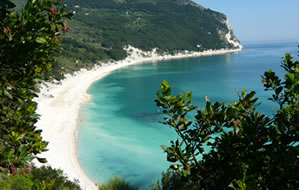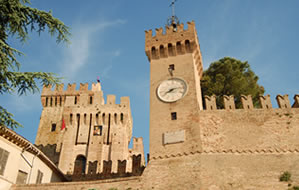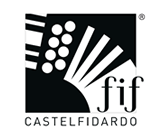Welcome to Castelfidardo
In the city of accordion there is a flurry of activities for the FIF, a Festival of international relevance with cultural shows and events.
Laid down between the Aspio and Musone Rivers Valleys, just two hundred metres above sea-level, Castelfidardo, the town of the accordion, as it is known in the whole world for its first industrial vocation of the reed instrument, is placed between the mountains and the sea.
Almost all the town churches have works of art of incredible beauty: the Collegiate Church, for example, with its “onion” shaped bell tower stands out in the panorama of Castelfidardo; St. Francis, which is today used as an Auditorium. conference and exhibition centre; St. Augustus, used as headquarters by Cialdini in 1860; St. Mary Mercy, with its artistic nativity scene and sixteenth century cotto flooring; the Monastery of St. Benedict – a girl’s college until very recently.
The historical buildings of Castelfidardo have always played an important role in the life of the city: the Town Hall which was reconstructed in the XVIth century, has a bell tower and Guelph crenallation, and houses a painting by Gallucci of the battle of Castelfidardo; Palazzo Mordini, which built by the benefactor of the town after which the building was named, is today used for cultural-historical exhibitions such as the Risorgimento museum exhibition while some of its halls house paintings and sculptures; Palazzo Soprani, which is perhaps the most important building of the town was commissioned by Paolo Soprani, founder of the Italian accordion industry and Mayor of Castelfidardo for many years in the early XXth century; also worthy of note is St. Anna’s Institute – one of the first public schools in Italy.
Close to the historical centre is the magnificent National Monument of Marche Region constructed at the beginning of the XXth century by the sculptor Vito Pardo to commemorate the Battle of Castelfidardo on 18 September 1860, which was decisive for the unity of Italy. A little further on we can find the monument to the Sacred Crucifix. At Crocette there is a Shrine to the fallen in the battle.
Castelfidardo has a central main vocation: the craftsmen who once hand crafted accordions started an international phenomenon that originates in Castelfidardo. Much of the accordion is produced still today by skilled hands that guarantee a warmth and originality to these instruments that have made them famous all over the world. Many of the internal components, such as the “reeds” which are the true heart of the instrument, are often produced by hand making these instruments not only valuable but unique. Castelfidardo today has diversified its production with galvanic, mechanical and electronic instruments… and is by right one of the most important industrial centres of Southern Ancona.

THE SEA
Sirolo and even Numana, Mezza Valle, Portonovo and Porto Recanati all have very famous and beautiful beaches with bathing establishments with playgrounds for children, food courts and water sport facilities; visitors may also enjoy a walk along the pedestrian beach fronts where children can play in perfect safety while cycling tracks offer delightful nature walks and rides.

CULTURE
10 km further on is the town of Recanati where visitors may see the home of Leopardi or visit Loreto with its sanctuary of the Holy House, one of the most-visited places of pilgrimage in the world. Just 10 minutes from Castelfidardo is Camerano where visitors can discover the underground city of the Caves. Offagna returns to its ancient splendour through the Mediaeval festivals in July which attract thousands of tourists for two event-packed weeks. The Frasassi Caves (Grotte di Frasassi) are situated within the Gola della Rossa gorge, and are a coveted destination for tourists coming from all parts of Italy and Europe. This fascinating subterranean world is populated by singular forms known as stalactites and stalagmites, small lakes, crystal and alabaster arabesques halls.










